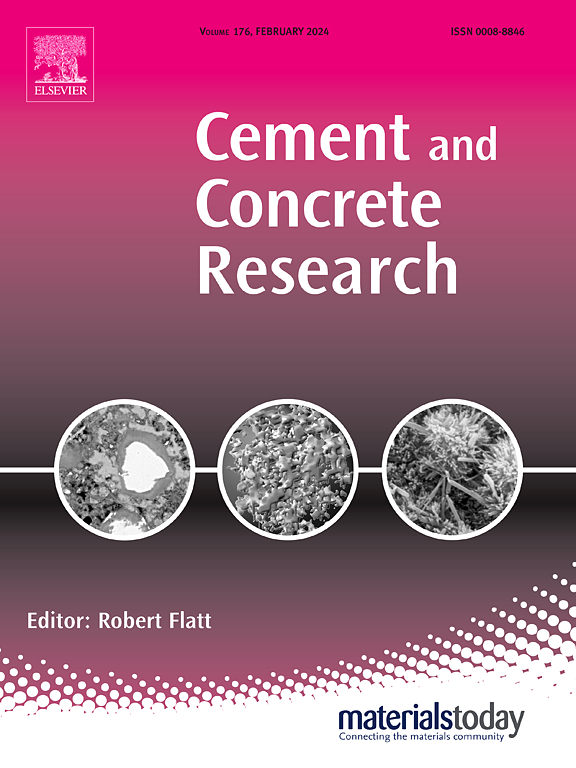Elucidating the behaviours and mechanisms of enforced carbonation in ferrite
IF 13.1
1区 工程技术
Q1 CONSTRUCTION & BUILDING TECHNOLOGY
引用次数: 0
Abstract
In this study, the carbonation behaviour and mechanisms of the ferrite (C4AF) phase in cement were investigated for the first time through enforced wet carbonation. The results confirm that ferrite carbonation is a spontaneous chemical reaction, the kinetics of which are predominantly controlled by monocarbonate precipitation. The carbonation process involved the initial precipitation of hemi/monocarbonate, followed by further carbonation to form Cc, amorphous Al(OH)3, and Fe(OH)3 as the final carbonation products. A unique products structure was identified, consisting of a Cc inner core enveloped by an iron-containing amorphous Al(OH)3 outer layer. The efficiency of carbonation was significantly enhanced by high initial pH, resulting in a >3.3-fold increase in the amount of calcium carbonate (Cc) compared to that observed in a neutral environment. Elevated initial pH levels enhance the dissolution of ferrite and CO₂, thereby increasing the concentration of Al(OH)₄− and prolonging the period of monocarbonate oversaturation, which substantially enhances the final carbonation degree. Additionally, higher initial pH suppresses the consumption of Al(OH)₄− by HCO₃−, favouring the precipitation of amorphous Al(OH)₃.
铁素体中强制碳化行为及机理的研究
本研究首次通过强制湿碳化研究了水泥中铁素体(C4AF)相的碳化行为和机理。结果表明,铁氧体碳酸化是一个自发的化学反应,其动力学主要受单碳酸盐沉淀控制。碳化过程包括半/单碳酸盐的初始沉淀,随后进一步碳化形成Cc、无定形Al(OH)3和Fe(OH)3作为最终碳化产物。产物结构独特,由含铁无定形Al(OH)3外层包裹的Cc内核组成。高初始pH显著提高了碳化效率,导致碳酸钙(Cc)的量比在中性环境下增加了3.3倍。初始pH值的升高促进了铁酸盐和CO 2的溶解,从而提高了Al(OH)₄−的浓度,延长了单碳酸盐过饱和的时间,从而大大提高了最终的碳化程度。此外,较高的初始pH抑制了HCO₃-对Al(OH)₄−的消耗,有利于无定形Al(OH)₃的沉淀。
本文章由计算机程序翻译,如有差异,请以英文原文为准。
求助全文
约1分钟内获得全文
求助全文
来源期刊

Cement and Concrete Research
工程技术-材料科学:综合
CiteScore
20.90
自引率
12.30%
发文量
318
审稿时长
53 days
期刊介绍:
Cement and Concrete Research is dedicated to publishing top-notch research on the materials science and engineering of cement, cement composites, mortars, concrete, and related materials incorporating cement or other mineral binders. The journal prioritizes reporting significant findings in research on the properties and performance of cementitious materials. It also covers novel experimental techniques, the latest analytical and modeling methods, examination and diagnosis of actual cement and concrete structures, and the exploration of potential improvements in materials.
 求助内容:
求助内容: 应助结果提醒方式:
应助结果提醒方式:


